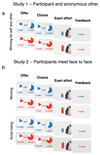Prosocial apathy for helping others when effort is required
- PMID: 28819649
- PMCID: PMC5555390
- DOI: 10.1038/s41562-017-0131
Prosocial apathy for helping others when effort is required
Abstract
Prosocial acts - those that are costly to ourselves but benefit others - are a central component of human co-existence1-3. While the financial and moral costs of prosocial behaviours are well understood4-6, everyday prosocial acts do not typically come at such costs. Instead, they require effort. Here, using computational modelling of an effort-based task we show that people are prosocially apathetic. They are less willing to choose to initiate highly effortful acts that benefit others compared to benefitting themselves. Moreover, even when choosing to initiate effortful prosocial acts, people show superficiality, exerting less force into actions that benefit others than themselves. These findings replicated, were present when the other was anonymous or not, and when choices were made to earn rewards or avoid losses. Importantly, the least prosocially motivated people had higher subclinical levels of psychopathy and social apathy. Thus, although people sometimes 'help out', they are less motivated to benefit others and sometimes 'superficially prosocial', which may characterise everyday prosociality and its disruption in social disorders.
Conflict of interest statement
Competing interest statement The authors declare that the research was conducted in the absence of any commercial, non-financial or financial relationships that could be construed as a potential conflict of interest.
Figures




References
-
- Fehr E, Camerer CF. Social neuroeconomics: the neural circuitry of social preferences. Trends Cogn Sci. 2007;11:419–427. - PubMed
-
- Fehr E, Fischbacher U. The nature of human altruism. Nature. 2003;425:785–91. - PubMed
-
- Fehr E, Rockenbach B. Human altruism: economic, neural, and evolutionary perspectives. Curr Opin Neurobiol. 2004;14:784–90. - PubMed
Grants and funding
LinkOut - more resources
Full Text Sources
Other Literature Sources

